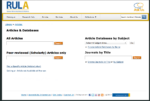As part of the ongoing effort to improve the website, I have been redesigning the website one section at a time. Earlier in the term, I did the Research Help section. In the last couple of weeks (that’s right, only about 2-3 weeks!), I worked on getting the ‘Articles’ section cleaned up with a new landing page.

Card Sort to Clean Up
 I knew that I wouldn’t have time to do a proper card sort study, but I decided to do a card sort with the web committee. We have enough people that I divided the committee up into two groups and gave them sticky notes with the names of the existing pages.
I knew that I wouldn’t have time to do a proper card sort study, but I decided to do a card sort with the web committee. We have enough people that I divided the committee up into two groups and gave them sticky notes with the names of the existing pages.
The sticky notes consistent all the local navigation links from the left side of the existing page and the second level links you see in the expanded part of the ‘More’ menu here (right). Then, I gave the usual instructions for a silent open card sort (no talking, group as you see fit).
While the purpose of a card sort is not to help clean up a section, it really got staff to see what fit in the Articles section and what didn’t. A lot of the pages were also deemed no longer relevant.
As a group, we made decisions on what to remove, and what to move and where. Quite a lot of the content was moved to either our subject research guides or our FAQ system.
There were one or two pages that we couldn’t decide what to do with, so for the time being they’ve been left where they are for now (e.g. RefWorks page is still in the ‘Articles’ menu though not linked on the landing page).
Mockups
With the pages that were left, I created a few mockups.
The web committee met again to discuss the mockups. I already had my heart set on either #2 or #3, because the whole idea is that it’s simple and clear. Having only one search bar with just a few links give users focus on what they’re looking for. Different people had different preferences on mockups, but with some discussion, the group settled on mockup #3 with a few revisions.
Staff Feedback
As with the research help page, I posted the revised Articles mockup in the staff room to give everyone a chance to provide feedback. This time, I didn’t get any feedback that resulted in any changes, so the final page is the same as the revised version.
New Page
Even though I’m on vacation, I wanted to get the new page up before the next term, so the new ‘Articles’ landing page went up this week.




